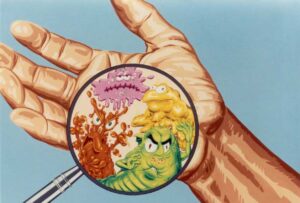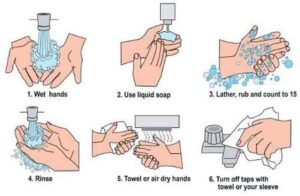Introduction
The Straight, No Chaser post looks at the relationship between your hygiene and illness.
There are things you know, there are things you know but don’t really know, and there are still other things that you think you know that you don’t know at all. When it comes to colds and influenza (both or which are simple to understand, prevent and treat), all of the above apply.
Are you sickly or do you get colds more frequently than others? Respectfully, a big part of that is because you have habits that put you at risk. Common things happen commonly.
Of course this is not an actual photo, but it’s a good depiction of what’s happening. Simply put, most of the day, your hands are pretty disgusting. You handle money that’s been handed hundreds if not thousands of times and never cleaned. You grab handles and door knobs all day long. You’re coughing and sneezing throughout the day, spewing germs into the air to be inhaled by others. And you spend time in the restroom. Your unclean hands contribute to many ailments, including colds, influenza, conjunctivitis (pink eye) and gastroenteritis (vomiting and diarrhea) and skin infections.
Lower Your Risk
The important points are simple things you can do to lower your risk for infections. First, you have to stop assuming you know more than you do about basic hygiene and allow yourself to start practicing better habits. For example …
- When you sneeze, do you sneeze into your hands or into the air around you? Please learn the habit covering your mouth and nose when you sneeze or cough by sneezing/coughing into your elbow and not your hands.
- How often do you wash your hands? You must wash every time you begin to cook, before you eat, after you use the rest room, before you change a diaper and before you apply any topical medicine.
- Have you ever noticed how much you keep your hands on parts of you that can become infected by doing so? Keep your hands out of your eyes, mouth and nose, and stop picking at your skin!
Yes, you wash your hands, but do you do so effectively and when you need to? Hand washing must be the easiest and most effective ways to prevent disease. Let’s start with this: from now on, whatever you do to clean your hands, do it for twenty seconds. Of course, antimicrobial soap and water are what we all learned to do way back when. It works! If that’s not available, use hand sanitizers or disposable hand wipes. It that’s not available, just rinse your hands! Be sure to rub your hands vigorously during the process as if you’re trying to get someone off of your hands, because you are!
Follow us!
Ask your SMA expert consultant any questions you may have on this topic. Also, take the #72HoursChallenge, and join the community. Additionally, as a thank you, we’re offering you a complimentary 30-day membership at www.72hourslife.com. Just use the code #NoChaser, and yes, it’s ok if you share!
Order your copy of Dr. Sterling’s books There are 72 Hours in a Day: Using Efficiency to Better Enjoy Every Part of Your Life and The 72 Hours in a Day Workbook: The Journey to The 72 Hours Life in 72 Days at Amazon or at www.jeffreysterlingbooks.com. Another free benefit to our readers is introductory pricing with multiple orders and bundles!
Thanks for liking and following Straight, No Chaser! This public service provides a sample of http://www.SterlingMedicalAdvice.com (SMA) and 844-SMA-TALK. Likewise, please share our page with your friends on WordPress! Also like us on Facebook @ SterlingMedicalAdvice.com! Follow us on Twitter at @asksterlingmd.
Copyright © 2018 · Sterling Initiatives, LLC · Powered by WordPress






























